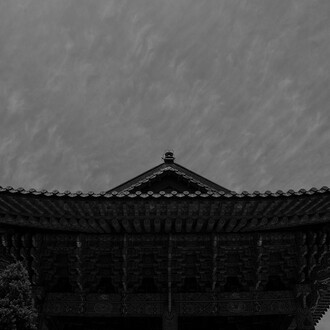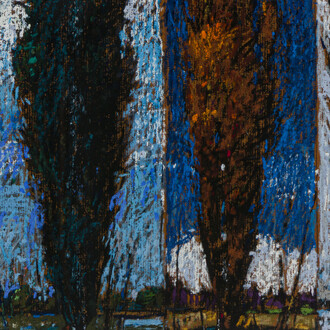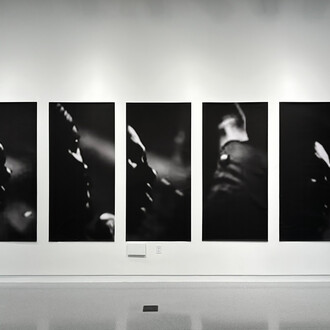Hollis Taggart will open its second solo exhibition of works by contemporary painter Alex Kanevsky. The exhibition, titled Liberation and Disorientation, will feature a selection of Kanevsky’s vibrant oil paintings, exploring a wide range of subjects, from land and seascapes to nudes to floral still lifes. Produced between 2018 and 2019—and most on view for the first time—the works highlight Kanevsky’s singular ability to capture the fluidity of time, through a blending of figurative and abstract approaches and rich use of color. Kanevsky’s paintings are imbued with emotional potency and the possibility of a narrative left untold. An opening reception, at which the artist will be present, will be held on September 5, from 6:00 to 8:00 PM. The exhibition will remain on view through September 28, 2019.
Inspired by the concept of unstable equilibrium in physics, Kanevsky, who studied theoretical mathematics at Vilnius University in Lithuania before pursuing an artistic career in the United States, creates compositions that defy easy interpretation and understanding. This is particularly felt in his treatment of the figure, which is often depicted in gestural, intentionally imprecise strokes against landscapes rendered with large swaths of color. Free of geographical and architectural markers, time, and orienting symbols, the figure is cast adrift within in an open field of possibility, leaving the viewer to discern and impose their own understanding of the scene. For Kanevsky this dislocation is essential to his practice, framing the experience as a “provocation” rather than a specific memory or moment caught on canvas. In this way, Kanevsky also sees his paintings as “visual poems,” emphasizing evocations of mood and atmosphere.
The power of Kanevsky’s paintings to compel emotion and engagement is intrinsically tied to his process. As he layers and works the canvas, prior approaches and experimentations are both removed and left visible, creating the sensation that the painting is teeming with action. Bright, shimmering colors collide, shifting the contours of the scene in and out of focus and producing the feeling of depth beneath the surface plane. The instability with which Kanevsky’s works are laced also extends to his treatment of the body, as he explores not only the inherent beauty of the human form but the ways in which it changes and moves, in quick motions and through the slow passage of time. These studies and experimentations result in paintings that feel both incredibly tactile and ephemeral.
In addition to a selection of nudes that encapsulate Kanevsky’s singular style and have become synonymous with his practice, Liberation and Disorientation will include seascapes from the artist’s recent residency at the Ballinglen Arts Foundation in Ballycastle, Ireland. Created in the only place where Kanevsky still paints en plein air, the paintings serve as a record of struggle: both Kanevsky’s own physical struggle while painting outside in adverse weather conditions (indeed, one of the canvases even has a dent from flying away) as well as the broader struggles of the people of Ireland. The views of the crashing waves, both lovely and melancholic, speak to the rugged terrain, which in itself elicits a range of emotions, while also providing a potent metaphor for the human experience.
Of his seascapes Kanevsky says, “Their fast movement was an observational problem. It was daunting, until I saw their cyclical nature. They repeat themselves often enough, and this makes it possible to paint directly from observation. Of course, this is not an exact repetition. The situation is similar to an artist painting a strange portrait: each time the artist looks at the sitter, there is a different person. A human face to be sure, but not the same. The result is not a portrait of a single individual, but an accumulative, if somewhat ambiguous, image of humanity.” Indeed, both Kanevsky’s seascapes and portraits possess a kind of inherent velocity that results from containing so many different moments in one still image.
The exhibition also includes paintings from the artist’s recent series Peony Variations (2019), in which Kanevsky applies his masterful brushwork to a peony set in the same place over the course of many days, capturing the minute changes in its postures and positions. Influenced by the variations of artists such as Matisse and Hokusai—as well as his interest in musical variations—Kanevsky says “I am interested in variations that begin with the subject, but then gradually become based on each other in succession.”
Kanevsky also sometimes draws inspiration from vintage photographs. One of the most evocative works in the exhibition, Girl with a Horse in Cerulleda (2019), began with Kanevsky’s fascination with a photograph he found while visiting a friend in a small town in Asturias, Spain, which depicts a small girl seated on a horse. In Kanevsky’s painterly interpretation, the girl—centered on a canvas stretching 5.5 by 5.5 feet— appears within the magnitude of the Picos de Europa which surround her home. The viewer is confronted by the girl’s seeming comfort and ownership of this vast expanse as well as by her incredible vulnerability within it, evoking a wide array of emotions and questions about her as a person in this landscape. The scene feels at once familiar and eerily foreign and incongruous, forcing the viewer to, once again, grapple with their own response.
Alex Kanevsky was born in Russia in 1963 and studied theoretical mathematics at Vilnius University in Lithuania before coming to the United States in the early 1980s. He settled in Philadelphia and began painting classes at the Philadelphia Academy of the Fine Arts in 1989. After receiving a Pew Fellowship in 1997, Kanevsky was able to devote himself to painting full time. He has exhibited his work throughout the United States, Canada, Italy, the United Kingdom, and Ireland, and currently lives and works in New Hampshire.
















